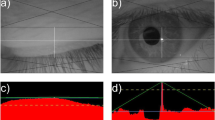Abstract
Several input interfaces that employ eye-blinking detection have been proposed. These input interfaces can detect operating intentions indicated by eye-blink actions. In this study, we propose a new blink input interface with the aim of increasing the classifiable blink types in addition to the regular voluntary blink. The proposed interface employs a sound feedback that facilitates multiple candidate selection. The feedback sound represents each input candidate and is generated while switching over time. This interface enables the user to input their operating intentions by controlling the timing of eye opening. We developed a prototype with the proposed interface and evaluated the system. The results indicated that a total classification rate of 96.5% is achieved for four types of voluntary blinks with 10 subjects. This classification rate is in accordance that of our previous report for two types of voluntary blinks. Thus, we concluded that our proposed method is reliable.





Similar content being viewed by others
References
Królak A, Strumiłło P (2012) Eye-blink detection system for human-computer interaction. Univ Access Inform Soc 11(4):409–419
MacKenzie IS, Ashtiani B (2011) BlinkWrite: efficient text entry using eye blinks. Univ Access Inform Soc 10(1):69–80
Molina-Cantero AJ, Lebrato-Vázquez C, Merino-Monge M, Quesada-Tabares R, Castro-García JA, Gómez-González IM (2019) Communication technologies based on voluntary blinks: assessment and design. IEEE Access 7:70770–70798
Krapic L, Kristijan L, Sandi L (2015) Integrating blink click interaction into a head tracking system: implementation and usability issues. Univ Access Inform Soc 14:247–264
Missimer E, Betke M (2010) Blink and Wink Detection for Mouse Pointer Control. In: 3rd international conference on pervasive technologies related to assistive environments (PETRA ’10), 23:1–8
Sato H, Abe K, Ohi S, Ohyama M (2017) A text input system based on information of voluntary blink and eye-gaze using an image analysis (in Japanese). IEEJ Trans EIS 137(4):584–594
Abe K, Sato H, Matsuno S, Ohi S., Ohyama M (2013) Automatic classification of eye blink types using a frame-splitting method. In: Proc. of the 15th international conference on Human-Computer Interaction, 16:117–124
Sato H, Abe K, Ohi S, Ohyama M (2017) An automatic classification method for involuntary and two types of voluntary blinks. Electron Commun Jpn 100(10):48–58
Sato H, Abe K, Ohi S, Ohyama M, (2014) A Real-time Image Analysis for Blink Type Classification under Natural Light (in Japanese). In: Proc. of, (2014) annual conference of electronics. Information and System society, IEE of Japan, pp 916–920
Author information
Authors and Affiliations
Corresponding author
Additional information
Publisher's Note
Springer Nature remains neutral with regard to jurisdictional claims in published maps and institutional affiliations.
This work was presented in part at the 25th International Symposium on Artificial Life and Robotics (Beppu, Oita, January 22-24, 2020).
About this article
Cite this article
Sato, H., Abe, K., Matsuno, S. et al. Blink input interface enabling multiple candidate selection through sound feedback. Artif Life Robotics 26, 312–317 (2021). https://doi.org/10.1007/s10015-020-00675-7
Received:
Accepted:
Published:
Issue Date:
DOI: https://doi.org/10.1007/s10015-020-00675-7




